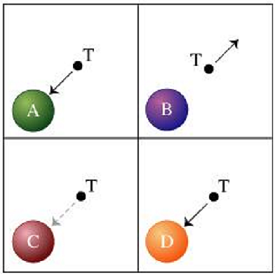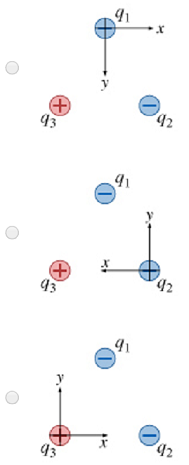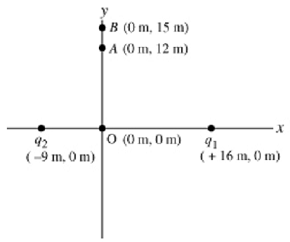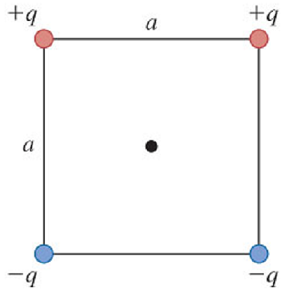Assignment Task: Electric Charge and Fields Questions
Section 1: A Test Charge Determines Charge on Insulating and Conducting Balls
Learning Goal: To understand the electric force between charged and uncharged conductors and insulators.
Consider three plastic balls (A, B, and C), each carrying a uniformly distributed charge equal to either +Q, -Q or zero, and an uncharged copper ball (D). A positive test charge (T) experiences the forces shown in the figure when brought very near to the individual balls. The test charge T is strongly attracted to A, strongly repelled from B, weakly attracted to C, and strongly attracted to D.
Assume throughout this problem that the balls are brought very close together.

Part A: What is the nature of the force between balls A and B?
Part B: What is the nature of the force between balls A and C?
Part C: What is the nature of the force between balls A and D?
Part D: What is the nature of the force between balls D and C?
Section 2: Coulomb's Law
Learning Goal: To practice Problem-Solving Strategy 21.1 Coulomb's Law.
Three charged particles are placed at each of three corners of an equilateral triangle whose sides are of length 3.6 cm. Two of the particles have a negative charge: q1 = -7.0 nC and q2 = -14.0 nC. The remaining particle has a positive charge, q3 = 8.0 nC. What is the net electric force acting on particle 3 due to particle 1 and particle 2?
Problem: Solving Strategy: Coulomb's law IDENTIFY the relevant concepts: Coulomb's law comes into play whenever you need to know the electric force acting between charged particles.
SET UP the problem using the following steps:
1. Make a drawing showing the locations of the charged particles, and label each particle with its charge.
2. If three or more particles are present and they do not all lie on the same line, set up an xy coordinate system.
3. Often you will need to find the electric force on just one particle. If so, identify that particle.
EXECUTE the solution as follows:
1. For each particle that exerts a force on the particle of interest, calculate the magnitude of that force using F = (1/4π∈0)(|q1q2|/r2).
2. Sketch a free-body diagram showing the electric force vectors acting on the particle(s) of interest due to each of the other particles. Recall that the force exerted by particle 1 on particle 2 points from particle 2 toward particle 1 if the two charges have opposite signs, but points from particle 2 directly away from particle 1 if the charges have the same sign.
3. Calculate the total electric force on the particle(s) of interest. Recall that the electric force, like any force, is a vector.
4. As always, using consistent units is essential. If you are given non-SI units, don't forget to convert!
5. If there is a continuous distribution of charge along a line or over a surface, divide the total charge distribution into infinitesimal pieces, use Coulomb's law for each piece, and then integrate to find the vector sum.
6. In many situations, the charge distribution will be symmetrical. Whenever possible, exploit any symmetry to simplify the problem-solving process.
IDENTIFY the relevant concepts - To determine the angle of the force vector on a single charged particle, you will need to calculate the vector sum of all the forces on that particle due to the presence of other charged particles. To do this, you will need to use Coulomb's law.
SET UP the problem using the following steps
Part A - Identify the most appropriate xy coordinate system.

Section 3: Questions
Q1. Two small plastic spheres are given positive electrical charges. When they are a distance of 14.5 cm apart, the repulsive force between them has a magnitude of 0.200 N.
Part A - What is the charge on each sphere if the two charges are equal?
Part B - What is the charge on first sphere if it has four times the charge of the other?
Part C - What is the charge on the second sphere?
Q2. Four identical charges Q are placed at the corners of a square of side L.
Part A: Find the magnitude total force exerted on one charge by the other three charges.
Section 4: Electric Fields and Forces
Learning Goal: To understand Coulomb's law, electric fields, and the connection between the electric field and the electric force.
Part A: There is a single electron at a distance from the point charge. On which of the following quantities does the force on the electron depend?
Part B: For the same situation as in Part A, on which of the following quantities does the electric field at the electron's position depend?
Section 5: Electric Field due to Multiple Point Charges
Two point charges are placed on the x axis. The first charge, q1 = 8.00 nC, is placed a distance 16.0 from the origin along the positive x axis; the second charge, q2 = 6.00 nC, is placed a distance 9.00 m from the origin along the negative x axis.

Part A: Calculate the electric field at point A, located at coordinates (0 m, 12.0 m).
Section 6: Questions
Q1. A point charge is placed at each corner of a square with side length a. The charges all have the same magnitude q. Two of the charges are positive and two are negative, as shown in the following figure.

Part A: What is the direction of the net electric field at the center of the square?
Part B: What is the magnitude of the net electric field at the center of the square due to the four charges in terms of q and a?
Note: Section 1 - A Test Charge Determines Charge on Insulating and Conducting Balls is completed. Need to do the rest.
Do you face difficulties while writing your Electric Charge and Fields assignments allocated by your professors and lecturers? Then approach our professional Electric Charge and Fields Assignment Help tutors for better academic grades.
Tags: Electric Charge and Fields Assignment Help, Electric Charge and Fields Homework Help, Electric Charge and Fields Coursework, Electric Charge and Fields Solved Assignments, Coulombs Law Assignment Help, Coulombs Law Homework Help
Attachment:- Electric Charge and Fields.rar